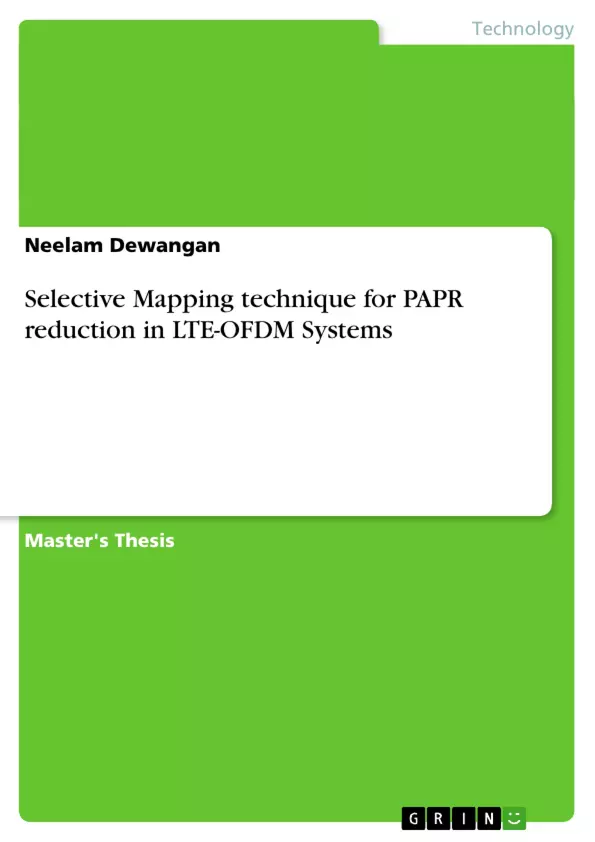As a promising technique, OFDM has been widely used in emerging broadband communication systems, such as digital audio broadcasting (DAB), high-definition television (HDTV), wireless local area network (IEEE 802.11a and HIPERLAN/2). However, as the OFDM signals are the sum of signals with random amplitude and phase, they are likely to have large PAPR that requires a linear high-power- amplifier (HPA) with an extremely high dynamic range, which is expensive and inefficient. Furthermore, any amplifier nonlinearity causes intermodulation products resulting in unwanted out-of-band power. A number of approaches have been proposed to deal with the PAPR problem, including clipping, clipping-and-filtering (CF), coding, companding transform, active constellation extension (ACE), selected mapping (SLM), partial transmit sequence (PTS), and so on.
This thesis proposes an improvement in Selected Mapping technique and Simulation results are compared to existing techniques namely Exponential Companding Transform, Repeated Clipping and Filtering and Adaptive Active Constellation Extension. The improvements which are proposed in classical Selective Mapping technique satisfies the PAPR Reduction criteria with reducing the computational complexity. Also this new scheme has an important advantage of avoiding the extra bits along with the transmitted OFDM signal .This scheme can also be applied to the multiple transmitting antenna cases.
Inhaltsverzeichnis (Table of Contents)
- ABSTRACT
- LIST OF ABBREVIATIONS
- LIST OF TABLES
- LIST OF FIGURES
- Chapter 1: Introduction
- 1.1 Multiple Access Schemes
- 1.2 Introduction to OFDM
- 1.3 Frequency Selective Fading
- 1.4 Multi-Carrier Modulation
- 1.4.1 Frequency Division Multiplexing
- 1.4.2 Time Division Multiplexing
- 1.5 OFDM System
- 1.5.1 Orthogonality
- 1.5.2 Bandwidth Utilization
- 1.6 Single Carrier FDMA and OFDMA
- 1.7 Advantages of OFDM
- 1.8 Disadvantages of OFDM
- 1.9 Cyclic Prefix
- Chapter 2: Peak to Average Power Ratio (PAPR)
- 2.1 Introduction
- 2.2 Definition of PAPR
- 2.3 Impact of PAPR on OFDM System
- 2.3.1 High Power Amplifier
- 2.3.2 Out-of-band Emission
- 2.4 Techniques for PAPR Reduction
- Chapter 3: PAPR Reduction Techniques
- 3.1 Clipping
- 3.2 Clipping and Filtering (CF)
- 3.3 Coding Techniques
- 3.4 Companding Transform
- 3.5 Active Constellation Extension (ACE)
- 3.6 Selected Mapping (SLM)
- 3.7 Partial Transmit Sequence (PTS)
- Chapter 4: Proposed PAPR Reduction Technique
- 4.1 Introduction
- 4.2 Proposed PAPR Reduction Technique
- 4.3 Computational Complexity
- Chapter 5: Simulation Results and Analysis
- 5.1 Simulation Environment
- 5.2 Simulation Results
- Chapter 6: Conclusion and Future Research
Zielsetzung und Themenschwerpunkte (Objectives and Key Themes)
This thesis investigates the issue of high peak-to-average power ratio (PAPR) in OFDM systems and proposes a novel approach for PAPR reduction. The work focuses on the impact of PAPR on system performance, particularly in relation to high power amplifiers and out-of-band emissions. The objectives are to: - Analyze the existing PAPR reduction techniques and their limitations. - Propose an improved PAPR reduction technique based on selective mapping. - Evaluate the performance of the proposed technique through simulation and compare it to existing techniques. - Examine the computational complexity of the proposed technique. Key themes explored in this thesis include: - PAPR reduction in OFDM systems. - Selective mapping for PAPR reduction. - Computational complexity analysis. - Simulation and evaluation of PAPR reduction techniques.Zusammenfassung der Kapitel (Chapter Summaries)
- Chapter 1: Introduction provides an overview of multiple access schemes and introduces OFDM as a promising technique for broadband communication systems. It discusses the advantages and disadvantages of OFDM, along with the concept of cyclic prefix.
- Chapter 2: Peak to Average Power Ratio (PAPR) defines PAPR and explains its impact on OFDM system performance. This chapter also explores various techniques used for PAPR reduction.
- Chapter 3: PAPR Reduction Techniques provides a detailed explanation of various PAPR reduction techniques such as clipping, clipping and filtering, coding, companding transform, active constellation extension, selected mapping, and partial transmit sequence.
- Chapter 4: Proposed PAPR Reduction Technique introduces a novel PAPR reduction technique based on selective mapping. It explains the proposed technique and analyzes its computational complexity.
- Chapter 5: Simulation Results and Analysis presents the simulation environment and results obtained from simulations. The chapter compares the performance of the proposed technique to existing techniques.
Schlüsselwörter (Keywords)
This thesis focuses on PAPR reduction in OFDM systems, specifically exploring the use of selective mapping as a technique to address this issue. The work explores various aspects related to PAPR, including its impact on system performance, the limitations of existing techniques, and the computational complexity of proposed solutions. Key terms related to this research include OFDM, PAPR, selective mapping, computational complexity, simulation, and performance evaluation.- Quote paper
- Neelam Dewangan (Author), 2012, Selective Mapping technique for PAPR reduction in LTE-OFDM Systems, Munich, GRIN Verlag, https://www.hausarbeiten.de/document/204995


